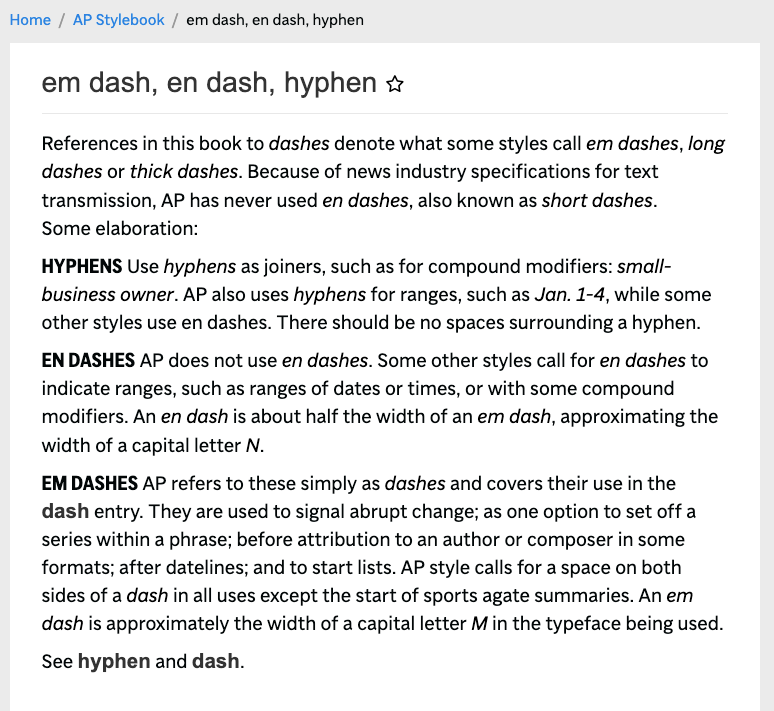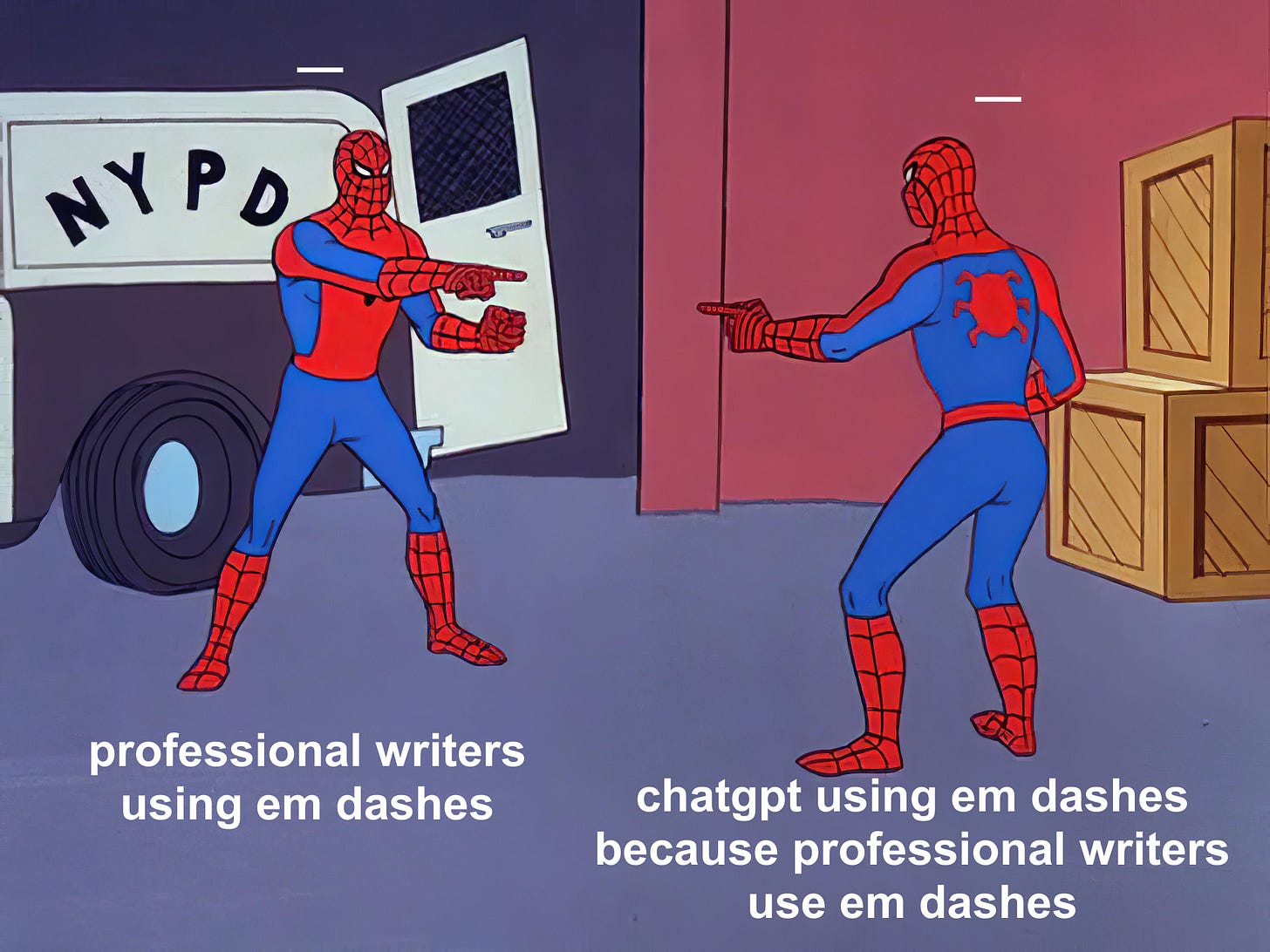What is the "AI em dash?"
How AI is making professional writers look bad with one punctuation mark
Welcome to Gen Z Translator, where I break down trending topics on Fridays. If you’re new, you can subscribe here and follow me on Instagram. Views are my own.
Writers around the internet have been scrambling to defend their use of the em dash in recent weeks as the punctuation mark comes under fire for its popularity with AI large language models. One of my favorite Substacks ended a recent edition with a footnote marking this crisis: “Did I use enough em-dashes in this sentence? It’s not AI, it’s just me, I promise.”
“A shortcut for detecting if something is written with AI is they all use this symbol ‘—’ throughout the writing,” @PaulSkallas wrote on X in February. “It's relatively rare when a human uses it, maybe once or twice, if that. But AI chats love using it. No clue why.”
“THATS BC MOST JOURNALISTS USE THE EM DASH AND THE AI IS TRAINED OFF THEIR STOLEN WORK. IT IS NOT AN INDICATOR OF AI IT IS A SYMPTOM OF THE CORE ISSUE,” an X user replied in defense.
YA writer Maggie Stiefvater responded with a similar message, saying, “It is possible that AI—which supposedly uses too many em dashes—does so because it was trained, in part—without my consent—on my novels, which also use too many em dashes.”
Punctuation nerds will know the em dash is particularly beloved by writers of all kinds – from poets to journalists to novelists (I say as a little bit of each). It’s harder to find em dashes in an average, written exchange because, in my personal opinion, most people would opt for easier conversation breaks over seeking out the computer command or keyboard character on their phone. To type an en dash on a Mac, one must hold down the Option key and press hyphen. To type an em dash, one must hold down option, press Shift, then press hyphen.
I must cut dozens of em dashes from my writing a week – I’d have one in every paragraph if I could – but after the unwanted attention, even I have been reconsidering my go-to punctuation mark. (Technically, I use an en dash [–] as opposed to an em dash [—] or hyphen [-]. I also leave spaces on either side in accordance with journalistic style guidance, unlike The Chicago Manual of Style, which uses a closed-in format just—like—this).
According to the Merriam-Webster Dictionary, the em dash can be used to “mark an abrupt change or break in the structure of a sentence,” “to emphasize or draw attention to parenthetical or amplifying material,” or “used in place of a colon or semicolon to link clauses,” among other uses.
The em dash has long been a point of contention. In 2019, The New York Times wrote an article about the symbol:
“The em dash is emphatic, agile and still largely undefined. Sometimes it indicates an afterthought. Other times, it’s a fist pump. You might call it the bad boy, or cool girl, of punctuation. A freewheeling scofflaw. A rebel without a clause.” -The New York Times, “The Em Dash Divides”
So, why has this become an AI thing?
@PaulSkallas shared a screenshot of a conversation with ChatGPT, which asked the artificial intelligence LLM1 about its use of AI. The bot replied, “Yes, Al chatbots tend to overuse the em dash – often as a crutch to connect ideas that could be separated into clearer sentences. While the em dash is a powerful tool, Al sometimes leans on it too much, using it where a comma, period, or even a colon might be more appropriate. This overuse makes the text feel artificially smooth but can also flatten the rhythm, making everything sound the same.”
Em dashes are naturally intellectual and thought-provoking. Which is why when employed in rather casual settings, like a homework discussion forum or an X post, it can easily give away someone’s use of AI. Particularly if it is a true em dash (—) symbol with no spaces and not the en dash (–), which is the easier one to use.
“Pro writers use em-dashes a lot because many of them, possibly without consciously realizing it, have become elocutionary punctuationists,” American software developer and author Eric S. Raymond explained on X. “That is, they've fallen into the habit of using punctuation not as grammatical phrase structure markers but as indicators of pauses of varying length in the flow of speech.”
It’s easy to accuse writers of using AI when in reality, it’s the AI who used their writing. It’s like that Spider-Man meme. Here, I’ll make it:
In a piece by The Guardian, global technology editor Dan Milmo reported that “last year, OpenAI admitted it would be impossible to train products such as ChatGPT without using copyright-protected material.”
This means books, music, movie scripts, dissertations, and journalism, all written by real humans, were used to train artificial intelligence to do its job better. The Atlantic created a searchable database if you’re interested in learning more about what was scraped. For example, Maggie Stiefvater’s work brings up 50 results in the pirated book database Meta used to train their AI. (Read more about The Atlantic’s methodology here).
“The Em Dash Debate is trending, because somebody pointed out you can identify AI because it uses -- a lot. Except then a bunch of pro writers jumped in to say that we use that a lot too,” an X user wrote. “Yeah. No kidding. AI uses that because they ripped us off when they programmed it.”
AI’s “pursuit of greatness” isn’t over. Sam Altman, the CEO of ChatGPT’s parent company, announced on March 11 that his company had “trained a new model that is good at creative writing.”
According to my calculations, the “metafictional literary short story about AI and grief” included 12 em dashes.
Unfortunately, the AI em dash is a tell. ChatGPT and other models favor it heavily in their responses. But, again – that’s because professional writers love to use the em dash and the AI is mimicking that.
As writers, it’s easy to want to come to the em dash’s defense because, of course, no professional writer wants to be unfairly accused of using AI in their work. However, I think it’s naive to ignore the correlation between the two just as it’s ignorant to claim every piece that includes an em dash is AI-generated.
My proposal? We all switch to en dashes and end the em dash witch-hunt once and for all. Better yet…let’s all use ellipses every time instead…Kidding. But please don’t yell at me for using the most gorgeous and versatile punctuation mark on the QWERTY keyboard.2
The best way to differentiate AI-generated writing from human writing is to teach yourself media literacy and use context clues. This whole debacle reminds us that there’s beauty in imperfect writing. Grammatical errors are a tell that we’re human. I hope we can continue to appreciate that for what it is, superfluous punctuation and all.
Read my last story: It's time for a 'Severance' performance review
My weekly roundup:
🎶 What I’m Listening To: “New Woman (feat. ROSALÍA)” by LISA, ROSALÍA
🎞️ What I’m Watching: The Severance season finale and White Lotus season finale in the same week is just cruel (edit: I’m dumb and didn’t do my math right. The White Lotus finale is definitely not this week)
🔎 What I’m Reading: Writing to Sell by Scott Meredith
📱 What I’m Scrolling: Speaking of reading, fans are going crazy over Sunrise on the Reaping by Suzanne Collins, the newest book set in The Hunger Games world
Note: I used 7 en dashes, 9 em dashes, and 15 hyphens in this piece. I sincerely apologize.
Read the full Gen Z Dictionary here.
LLM: Large language model
QWERTY keyboard: The standard keyboard that begins with the letters Q, W, E, R, T, and Y









Yes—so much yes. Thank you, Rachel. These damn em-dash truthers can chill. You and I stand in a long, proud lineage of em-dash devotees—Emily Dickinson, James Baldwin, C.D. Wright.
Smart writers have always used them for clarity, rhythm, and compression. They’re a tool of control, not a giveaway.